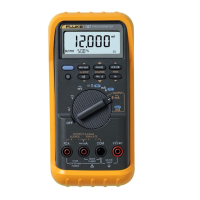Calibration Manual
Verification Tests
23
DC Volts Measurement Tests
XWarning
To avoid possible electrical shock or personal injury:
•
Some of the verification tests involve the use of high voltages and
should be performed by qualified personnel only.
•
Always place the calibrator in the Standby (STBY) mode between
tests and before handling the test connections or test cables.
1. Put the calibrator in Standby (STBY) mode.
2. Put the UUT rotary switch in the
L (dc volts) position; select the autoranging mode.
3. Connect the calibrator to the
COM and z terminals on the UUT as shown in
Figure 10.
4. Apply the values from the calibrator shown in Table 9 and compare the readings on
the UUT to the acceptable readings shown.
Table 9. DC Volts Test
787 Range Calibrator DC Voltage Minimum Reading Maximum Reading
4 V dc 1 V 0.998 V 1.002 V
4 V dc 3 V 2.996 V 3.004 V
40 V dc 10 V 9.98 V 10.02 V
40 V dc 30 V 29.96 V 30.04 V
400 V dc 100 V 99.8 V 100.2 V
400 V dc 300 V 299.6 V 300.4 V
1000 V dc 100 V 99 101
1000 V dc 800 V 798 802
AC Volts Measurement Test
XWarning
To avoid possible electrical shock or personal injury:
•
Some of the verification tests involve the use of high voltages and
should be performed by qualified personnel only.
• Always place the calibrator in the Standby (STBY) mode between
tests and before handling the test connections or test cables.
1. Put the calibrator in Standby (STBY) mode.
2. Put the UUT rotary switch in the
K (ac volts) position.
3. Connect the calibrator to the
COM and z terminals on the UUT as shown in
Figure 10.
4. Apply the values from the calibrator shown in Table 10 and compare the readings on
the UUT to the acceptable readings shown.

